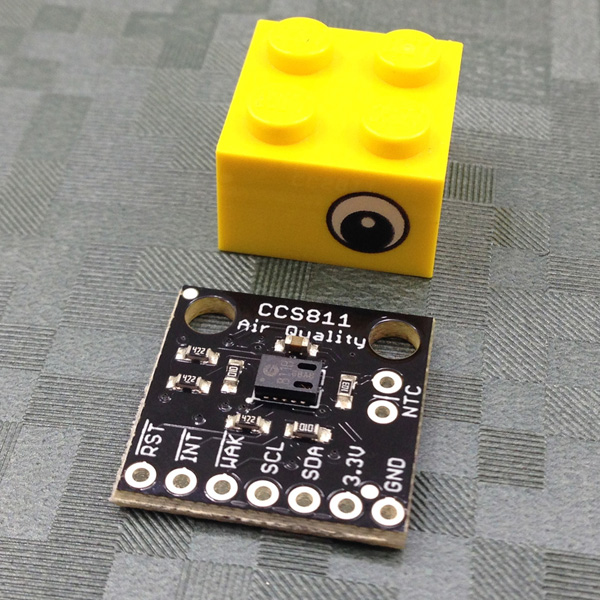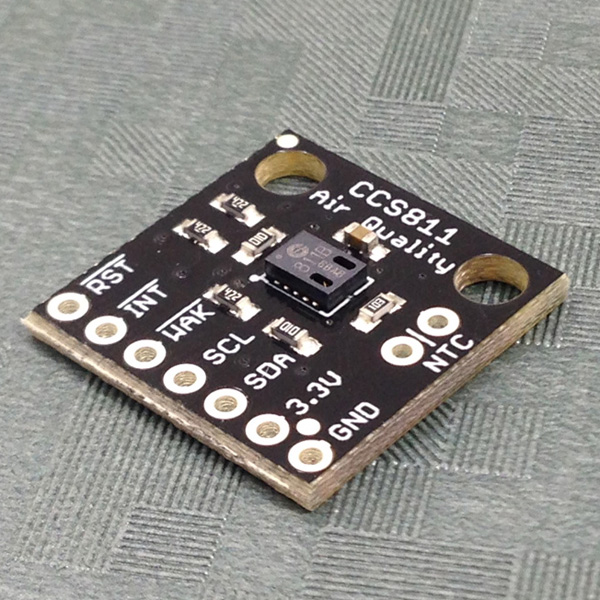Descrizione
The CCS811 is a sensor for detecting the level of carbon dioxide (CO2) and Total Volatile Organic Compounds (TVOCs) in the air. TVOC combined with CO2 is used to measure indoor air quality or IAQ. CO2 is produced by human respiration, and VOCs come from construction materials (paint, carpet, etc), machines (copiers, processes, etc), and people (breathing, cigarettes, etc). VOCs are often categorized as pollutants and/or sensory irritants.
TVOC is a roughly defined term, and we’re still wrapping our heads around what this sensor can do. Effectively, it can give you the parts per million (PPM) readings of CO2 and parts per billion (PPB) readings of TVOCs. Please note that the CCS811 datasheet recommends a burn-in of 48 hours and a run-in of 20 minutes (you must allow 20 minutes for the sensor to warm up and output valid data).
Outdoor CO2 can range from 300 to 500ppm. Indoor air with CO2 levels below 700ppm is considered acceptable. “Indoor CO2 concentrations of 1000 to 1200 ppm in spaces housing sedentary people is an indicator that a substantial majority of visitors entering the space will be satisfied with respect to human bioeffluents (body odor).”(from ASHRAE)
From the report titled “TVOCs in Indoor Air Quality Investigations”:
In view of the fact that there are few controlled human exposure studies and the results are not confirmed, and that the results of epidemiological studies are inconsistent, it is today not possible to conclude that sensory irritation is associated with the sum of mass concentrations of VOCs at the low exposure levels typically encountered in non-industrial indoor air. Therefore, although the likelihood of sensory effects will increase with increasing TVOC concentration, at present no precise guidance can be given on which levels of TVOC are of concern from a health and comfort point of view, and the magnitude of protection margins needed cannot be estimated. Nevertheless, the general need for improved source control to diminish the pollution load on the indoor environments from health, comfort, energy efficiency and sustainability points of view leads to the recommendation that VOC levels in indoor air should be kept as low as reasonably – achievable (ALARA).
CO2 and TVOC sensing is an intriguing and complex field, and we’ve barely scraped the surface. The CCS811 is simply the first to provide base level sensing to the hacker level mad scientist.
We do not plan to regularly produce SparkX products so get them while they’re hot!
Uses of TVOC sensing:
- Testing of materials for chemical emission (that new car smell)
- Indicator of insufficient or poorly designed ventilation
- Identification of high polluting activities
Uses of CO2 sensing:
- Indoor Agriculture including aqua- and hydroponics
- Room occupants and HVAC loading
Features:
- CO2 sensing from 400 to 8192 parts-per-million
- Total Volatile Organic Compound (TVOC) sensing from 0 to 1187 parts-per-billion
Documents:
- CCS811 Datasheet
- Here are a handful of example sketches to get you started
- Schematic
- Eagle Files
- To get the latest files, visit the GitHub repo
Additional CCS811 Datasheets:
- Programming Guide
- Assembly Guidelines
- Mechanical Considerations
- Firmware Download (advanced feature for loading new firmware onto the sensor)
Exposure and concentration limit recommendations by various organizations:
- European Collaborative Action report on TVOCs in Indoor Air Quality Investigations
- Introduction to VOCs and Health by Berkeley Lab
- Wikipedia article on Indoor Air Quality
- The Australian Government specifically excludes certain compounds (like CO, methane, etc) from the definition of ‘TVOC’. It’s unclear how universal this is.
- Smithsonian article on CO2 in the workplace









Recensioni
Ancora non ci sono recensioni.